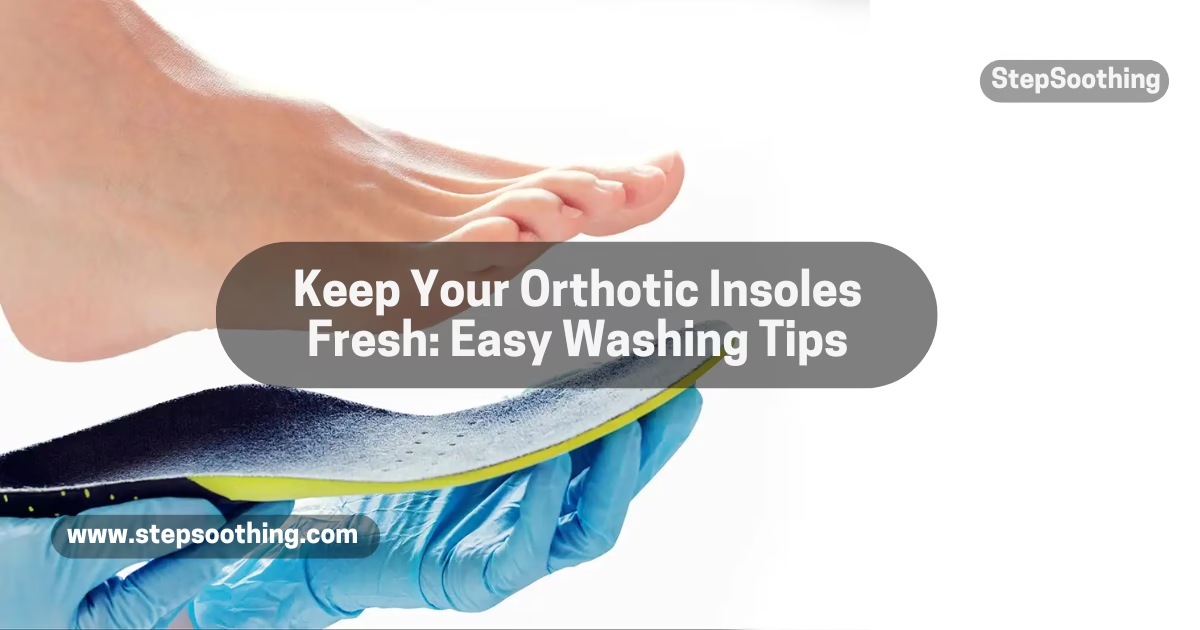Orthotic insoles offer essential support and comfort, but like any frequently used item, they require regular cleaning to maintain both hygiene and effectiveness. Over time, dirt, sweat, and bacteria can build up, leading to odors and potential skin issues. Proper cleaning not only extends the lifespan of your insoles but also ensures they remain comfortable and safe for daily use.
By following a few easy steps and using simple, gentle materials, you can keep your orthotic insoles fresh and in optimal condition. From brushing off dirt and using a mild soap solution to carefully air-drying, each step helps preserve the structure of the insoles while eliminating harmful buildup. With this guide, you’ll be able to clean your insoles thoroughly without risking damage, ensuring they continue to provide the support your feet need.
Washing Instructions for Orthotic Insoles
Orthotic insoles are a game-changer for anyone looking to improve comfort and support for their feet, but keeping them clean is key to maintaining their performance. Here’s a complete guide to properly washing your orthotic insoles.
Why Clean Orthotic Insoles Are Essential
Keeping your orthotic insoles clean not only extends their life but also keeps your feet healthy. Regular cleaning removes bacteria, sweat, and dirt that can build up over time, making your insoles more comfortable and hygienic.
Benefits of Regularly Cleaning Insoles
Cleaning your insoles prevents odor buildup, eliminates harmful bacteria, and keeps them in their best shape. A quick wash can rejuvenate your insoles, giving you a fresh feel with every wear.
How Dirty Insoles Can Affect Foot Health
When dirt and bacteria accumulate on insoles, it can cause skin irritation and even infections. Clean insoles are essential for anyone dealing with sensitive skin or foot conditions like athlete’s foot.
Materials Needed for Washing Orthotic Insoles
You don’t need fancy supplies to clean orthotic insoles. With the right materials and techniques, you can effectively wash your insoles and keep them in top condition. Here’s what you’ll need.
Recommended Cleaning Supplies
A soft-bristled brush, mild soap, water, a soft cloth, and a clean towel are usually sufficient. Avoid abrasive tools or harsh chemicals, which can damage the insole material.
Avoid These Cleaning Products
Stay away from bleach, alcohol-based cleaners, and harsh detergents, as these can break down the materials in orthotic insoles, reducing their lifespan and effectiveness.
Step-by-Step Washing Guide for Orthotic Insoles
Ready to wash your insoles? Follow these steps carefully to keep them fresh and functional without damaging their structure.
Step 1: Remove Insoles from Shoes
Take out the insoles from your shoes. This not only makes washing easier but also helps air out the shoes themselves, which can reduce odors in both the shoes and insoles.
Step 2: Brush Off Loose Dirt
Use a soft brush to gently remove any dirt or debris from the insoles. This initial step makes the washing process more effective and prevents dirt from embedding further into the material.
Step 3: Prepare a Cleaning Solution
Fill a basin with lukewarm water and add a small amount of mild soap. Avoid hot water, as it can weaken adhesive or foam materials in the insoles.
Step 4: Hand-Wash the Insoles
Dip a soft cloth or brush in the soapy water and gently scrub the surface of the insoles. Be careful not to soak the insoles; a damp clean is typically sufficient.
Using a Soft Brush or Cloth
A soft brush or microfiber cloth works best for scrubbing without damaging delicate insole material. Avoid hard scrubbing, as it can wear down the insole’s support.
Avoiding Water Damage
Do not fully submerge your insoles, especially if they are made with layers or special materials. Spot cleaning with damp cloths keeps them clean without the risk of water damage.
Step 5: Rinse Thoroughly
After scrubbing, use a damp cloth to wipe off any soap residue. Make sure there’s no leftover soap, as it can cause irritation during wear.
Step 6: Air-Dry the Insoles
Place the insoles in a well-ventilated area to air-dry. Avoid direct sunlight or heat sources like radiators, as these can cause shrinkage or hardening of the insoles.
Best Practices for Drying Orthotic Insoles
Letting insoles air-dry completely is essential before placing them back in your shoes. Speed up drying by laying them on a dry towel, but never wring them out.
Alternative Cleaning Methods for Orthotic Insoles
In addition to traditional washing, there are a few alternative methods to keep insoles clean and odor-free.
Using Baking Soda for Deodorizing
Sprinkle baking soda over the insoles and leave them overnight to absorb any lingering odors. Brush off in the morning for a fresh, odor-free start.
Vinegar Solution for Deep Cleaning
For extra freshness, mix equal parts water and white vinegar. Lightly mist the insoles, then wipe with a soft cloth to remove odors and bacteria.
Mistakes to Avoid When Cleaning Orthotic Insoles
Certain cleaning mistakes can damage orthotic insoles and reduce their longevity. Avoid these common pitfalls.
Common Mistakes That Ruin Insoles
Avoid machine washing, using hot water, and applying harsh chemicals. These can weaken the materials and destroy the insole’s supportive structure.
How to Preserve Insole Shape and Structure
Avoid twisting, wringing, or bending the insoles. Keep them flat and allow them to dry naturally to maintain their original shape.
How Often Should You Clean Orthotic Insoles?
The frequency of cleaning insoles depends on usage and environmental factors. Regular cleaning helps maintain hygiene and prolongs their lifespan. For daily-use insoles, washing every 1-2 weeks is ideal, especially in active or warm environments. Occasional-use insoles may need cleaning once a month. Always follow care instructions to avoid damage. Proper maintenance ensures comfort and reduces odors, keeping your footwear fresh and supportive for longer periods.
Factors Affecting Cleaning Frequency
Consider how often you wear the insoles, your level of activity, and environmental factors like humidity, which can lead to quicker odor buildup.
Suggested Cleaning Schedule for Optimal Results
For regular use, clean your insoles every two weeks. If you’re particularly active, consider weekly cleaning for best results.
Conclusion
Orthotic insoles are a valuable addition to your footwear, providing comfort and support. With proper cleaning, you can enjoy these benefits while keeping your insoles fresh and durable. Regular maintenance will ensure your insoles continue to perform at their best.
People Also Asked
Can I Machine Wash Orthotic Insoles?
No, machine washing can damage the structure of orthotic insoles. Hand-washing is safer and more effective.
What if My Insoles Have Stubborn Odors?
Try using baking soda or a vinegar solution to eliminate persistent odors. These natural methods work well without harming the insoles.
How Long Do Orthotic Insoles Last?
With proper care, most orthotic insoles last between 6 months and a year, depending on usage.
Can I Wear Insoles While They’re Still Damp?
No, wearing damp insoles can lead to mold and bacteria growth. Ensure they’re completely dry before using them.
Are There Any Quick-Clean Solutions for Insoles?
Yes, a quick sprinkle of baking soda or a light vinegar mist can freshen up insoles in between washes.
Key Points for Washing Orthotic Insoles
- Importance of Cleaning: Regularly cleaning orthotic insoles keeps them hygienic, prevents odor, and prolongs their life.
- Materials Needed: A soft-bristled brush, mild soap, a soft cloth, and water are ideal. Avoid harsh chemicals or abrasive tools.
- Step-by-Step Washing:
- Remove Insoles: Take them out of shoes for easier cleaning.
- Brush Off Dirt: Use a soft brush to remove loose debris.
- Prepare Solution: Use lukewarm water and mild soap.
- Hand-Wash Carefully: Gently scrub without fully soaking the insoles.
- Rinse and Air-Dry: Wipe with a damp cloth to remove soap, then air-dry in a well-ventilated area away from heat sources.
- Alternative Cleaning Options: Use baking soda for deodorizing or a diluted vinegar solution for deeper cleaning.
- Common Mistakes to Avoid: Avoid machine washing, wringing, or using hot water, as these can damage the insoles.
- Cleaning Frequency: Clean every 1-2 weeks for regular use, or more frequently if used in active settings.



